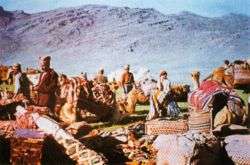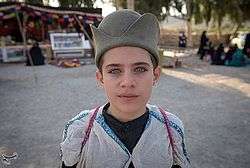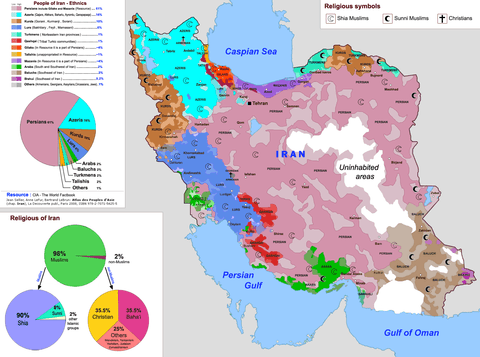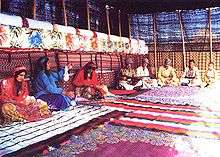Qashqai people
Qashqai (pronounced [ɢæʃɢɒːˈjiː]; also spelled Qashqa'i, 'Qashqay,' Kashkai, Kashkay, Qashqayı, Gashgai, Gashgay, Ghashghaei, in Persian: قشقایی) is a conglomeration of clans in Iran consisting of mostly Turkic peoples but also Lurs, Kurds and Arabs.[4] Almost all of them speak a Western Oghuz Turkic dialect known as the Qashqai language, which they call "Turki", as well as Persian (the national language of Iran) in formal use. The Qashqai mainly live in the provinces of Fars, Khuzestan, Kohgiluyeh and Boyer-Ahmad, Chaharmahal and Bakhtiari, Bushehr and Southern Isfahan, especially around the cities of Shiraz and Firuzabad in Fars. The majority of Qashqai people were originally nomadic pastoralists and some remain so today. The traditional nomadic Qashqai travelled with their flocks twice yearly to and from the summer highland pastures north of Shiraz roughly 480 km or 300 miles south to the winter pastures on lower (and warmer) lands near the Persian Gulf, to the southwest of Shiraz. The majority, however, have now become partially or wholly sedentary. The trend towards settlement has been increasing markedly since the 1960s.
  Qashqai traditional market (top) Qashqai boy wearing a traditional hat (bottom) | |
| Total population | |
|---|---|
| 2,949,000[1] | |
| Regions with significant populations | |
| Southern Iran, Central Iran | |
| Languages | |
| Qashqai, | |
| Religion | |
| Shia Islam[2] | |
| Related ethnic groups | |
| Mostly Turkic peoples (also Lurs, Kurds, Arabs)[3] |
The Qashqai are made up of five major tribes: the Amale (Qashqai) / Amaleh (Persian), the Dere-Shorlu / Darreh-Shuri, the Kashkollu / Kashkuli, the Shishbeyli / Sheshboluki and the Eymur / Farsimadan.[5] Smaller tribes include the Qaracha / Qarache'i, Rahimli / Rahimi and Safi-Khanli / Safi-Khani.
History

Historically, the Turkic languages are believed to have arrived in Iran from Central Asia from the 11th or 12th centuries onwards.
- "To survive, nomads have always been obliged to fight. They lead a wandering life and do not accumulate documents and archives.
- But in the evenings, around fires that are burning low, the elders will relate striking events, deeds of valour in which the tribes pride themselves. Thus the epic tale is told from father to son, down through the ages.
- The tribes of Central Asia were forced by wars, strife, upheavals, to abandon their steppes and seek new pasture grounds...so the Huns, the Visigoths, and before them the Aryans, had invaded India, Iran, Europe.
- The Turks, forsaking the regions where they had dwelt for centuries, started moving down through the Altai Mountains and Caspian depressions, establishing themselves eventually on the frontiers of the Iranian Empire and in Asia Minor.
- Though these versions differ, we believe that the arrival of our Tribes in Iran coincided with the conquests of Ghengis Khan, in the thirteenth century. Soon after, our ancestors established themselves on the slopes of the Caucasus. We are descendants of the "Tribe of the Ak Koyunlu" the "Tribe of the White Sheep" famed for being the only tribe in history capable of inflicting a defeat on Tamerlane. For centuries we dwelt on the lands surrounding Ardebil, but, in the first half of the sixteenth century we settled in southern Persia, Shah Ismail having asked our warriors to defend this part of the country against the intrusions of the Portuguese. Thus, our Tribes came to the Province of Fars, near the Persian Gulf, and are still only separated from it by a ridge of mountains, the Makran.
- The yearly migrations of the Kashkai, seeking fresh pastures, drive them from the south to the north, where they move to their summer quarters "Yailaq" in the high mountains; and from the north to the south, to their winter quarters, "Qishlaq".
- In summer, the Kashkai flocks graze on the slopes of the Kuh-è-Dinar; a group of mountains from 12,000 to 15,000 feet, that are part of the Zagros chain.
- In autumn the Kashkai break camp, and by stages leave the highlands. They winter in the warmer regions near Firuzabad, Kazerun, Jerrè, Farashband, on the banks of the river Mound, till, in April, they start once more on their yearly trek.
- The migration is organised and controlled by the Kashkai Chief. The Tribes carefully avoid villages and towns such as Shiraz and Isfahan, lest their flocks, estimated at seven million head, might cause serious damage. The annual migration is the largest of any Persian tribe.
- It is difficult to give exact statistics, but we believe that the Tribes now number 400,000 men, women and children." Told to Marie-Tèrése Ullens de Schooten by the 'Il Begh' Malek Mansur, brother of the 'Il Khan', Nasser Khan, Chief of the Kashkai Tribes, in 1953.[6]
The Qashqai were a significant political force in Iran during the late 19th and early 20th centuries. During World War I they were influenced by the German consular official Wilhelm Wassmuss and sided with the Germans.[7] During World War II the Qashgais attempted to organize resistance against the British and Soviet occupation forces and received some ineffectual help from the Germans in 1943 by the means of Operation ANTON, which (along with Operation FRANZ) proved a complete failure.[8] In 1945–1946 there was a major rebellion of a number of tribal confederacies, including the Qashgais, who fought valiantly until the invading Russians were repelled. The Qashgais revolted during 1962–1964 due to the land reforms of the White Revolution.[9] The revolt was put down and within a few years many Qashqais had settled.[9] Most of the tribal leaders were sent to exile. After the Iranian Revolution of 1979 the living leader, Khosrow Khan Qashqai, returned to Iran from exile in the United States and Germany.
Major Tribes of the Qashqai Tribal Confederation
The Qashqai tribal confederation consists of five major tribes, including the Dareshuri, Farsimadan, Sheshboluki, Amaleh, and Kashkuli.[10]
Amale / Amaleh
People of the Amaleh tribe were originally warriors and workmen attached to the household of the Ilkhani, or paramount chief; recruited from all the Qashqai tribes they constituted the Ilkhani’s bodyguard and retinue.[11] By 1956, the Amaleh tribe comprised as many as 6,000 families.[12]
Dere-Shorlu / Dareshuri / Darehshouri
The Dareshuri are said to have joined the Qashqai tribal confederation during the reign of Karim Khan Zand (1163-93/1750-79).[13] According to Persian government statistics, there were about 5,169 Dareshuri families, or 27,396 individuals, in 1360 sh./1981.[14] The Dareshuri were “the greatest horse-breeders and owners among the Qashqai”. The policy of forced sedentarization of the nomadic tribes pursued by Reza Shah Pahlavi (1304–20 SH./1925-41) resulted in the loss of 80–90 percent of the Dareshuri horses, but the tribe made a recovery after World War II.[15] Reza Shah Pahlavi also executed Hossein khan Darehshouri the head of Darehshouri family in order to take back the control of the Fars province which was controlled by Darehshouri tribe during Ghajar empire.
Kashkollu / Kashkuli
During World War I, the Kashkuli khans supported the British in their struggle against Ṣowlat-al-Dowla (Iyl-khan) and the German agent, Wilhelm Wassmuss. After the war, Ṣowlat-al-Dowla punished the Kashkuli. He dismissed the Kashkuli leaders who had opposed him and “deliberately set out to break up and impoverish the Kashkuli tribe”.[16] Two sections of the tribe, which consisted of elements which had been loyal to Ṣowlat-al-Dowla, were then separated from the main body of the tribe and given the status of independent tribes, becoming the Kashkuli Kuchak (“Little Kashkuli”) and Qarachahi tribes. The remaining tribe became known as the Kashkuli Bozorg (“Big Kashkuli”) tribe.[17] The Kashkuli Bozorg tribe comprised 4,862 households in 1963. As Oliver Garrod observed, the Kashkuli Bozorg are “especially noted for their Jajims, or tartan woolen blankets, and for the fine quality of their rugs and trappings”.[18]
Eymur / Farsimadan
The Farsimadan claim that they are of Ḵhalaj origin, and that, before moving to southern Persia, they dwelled in Ḵalajestan, a region southwest of Tehran.[19] The tribe was already in Fars by the late 16th century, for it is known that in October 1590 their leader, Abul-Qasem Beyg and some of his followers were punished for having sided with Yaqub Khan the Zul-Qadr governor of Fars, in a revolt against Shah Abbas I.[20] The population of the Farsimadan was estimated by Afshaar-Sistaani at 2,715 families or 12,394 individuals, in 1982.[21]
Qashqai carpets and weavings
The Qashqai are renowned for their pile carpets and other woven wool products. They are sometimes referred to as "Shiraz" because Shiraz was the major marketplace for them in the past. The wool produced in the mountains and valleys near Shiraz is exceptionally soft and beautiful and takes a deeper color than wool from other parts of Iran.
- "No wool in all Persia takes such a rich and deep colour as the Shiraz wool. The deep blue and the dark ruby red are equally extraordinary, and that is due to the brilliancy of the wool, which is firmer and, so to say, more transparent than silk, and makes one think of translucent enamel".[22]
Qashqai carpets have been said to be "probably the most famous of all Persian tribal weavings".[23] Qashqai saddlebags, adorned with colorful geometric designs, "are superior to any others made".[24]
Culture

The Qashqai are pastoral nomads who rely on small-scale cultivation and shepherding. Traditional dress includes the use of decorated short tunics, wise-legged pants, and headscarfs worn by women.[25]
Cultural references
- In 2006, Nissan named its new European small SUV "Qashqai", after the Qashqai people.[26][27][28] The designers believe that the buyers "will be nomadic in nature too".[29] The new unconventional name was however met with surprise and even skepticism.[30]
- In Philip Kerr's political fiction novel, Hitler's Peace,[31] Qashqai fighters are used by the Abwehr in an operation aimed at assassinating the three Allied leaders convened in the Tehran Conference. Betrayed to the Soviets, they are then executed by the NKVD. This is pure fiction, as is the legend of Operation Long Jump (Weitsprung), concocted and promulgated into the 21st century by Soviet security (NKVD/KGB) to inflate their contribution to pre-emptive security measures at the Big Three conference.[32]
See also
- Qashqai language
- Qashqai Football Club
- Iranian Turks
- Bichaghchi (tribe)
- Yaylag
- Yörüks
- Qishlaq
Footnotes
- "Kashkay". Retrieved 6 February 2018.
- Adamec, Ludwig W. (2017). Historical Dictionary of Islam (3 ed.). Rowman & Littlefield. p. 515. ISBN 978-1442277243.
- "QAŠQĀʾI TRIBAL CONFEDERACY i. HISTORY". Retrieved 13 May 2015.
- "QAŠQĀʾI TRIBAL CONFEDERACY i. HISTORY". "Like most present-day tribal confederacies in Persia, the Il-e Qašqāʾi is a conglomeration of clans of different ethnic origins, Lori, Kurdish, Arab and Turkic. But most of the Qašqāʾi are of Turkic origin, and almost all of them speak a Western Ghuz Turkic dialect which they call Turki." In: Encyclopaedia Iranica. Retrieved 13 May 2015.
- Dolatkhah, Sohrab (2016). Le qashqay: langue turcique d'Iran. Online: CreateSpace, Independent Publishing Platform. p. 13.
- Ullens de Schooten, Marie-Tèrése. (1956). Lords of the Mountains: Southern Persia & the Kashkai Tribe. Chatto and Windus Ltd. Reprint: The Travel Book Club. London, pp. 53–54. See also pp. 114–118.
- Ullens de Schooten, Marie-Tèrése. (1956). Lords of the Mountains: Southern Persia & the Kashkai Tribe. Chatto and Windus Ltd. Reprint: The Travel Book Club. London, p. 114.
- O'Sullivan, Adrian. (2014) Nazi Secret Warfare in Occupied Persia (Iran): The Failure of the German Intelligence Services, 1939–45>Nazi Secret Warfare, pp. 58 passim.
- Federal Research Division, p.125
- Encyclopaedia Iranica. "QAŠQĀʾI TRIBAL CONFEDERACY i". Retrieved 5 May 2015.
- Magee, G. F. (1948). The Tribes of Fars. p. 71.
- Pierre, Oberling (1974). The Qashqai Nomads of Fars. p. 223.
- Beck, Lois (1986). The Qashqai of Iran (1st ed.). New Haven, CT: Yale University Press. ISBN 0300032129.
- Afshaar-Sistaani, Iraj (1987). Eall-ha, Chaadorneshinan va ṭavayef-e ashayeri-e Iran. Tehran: Iraj Afshaar.
- Oberling, Pierre (June 1974). The Qashqai Nomads of Fars. Walter De Gruyter Inc. p. 277. ISBN 9992263113.
- Magee, G. F. (1945). The Tribes of Fars. London. p. 79.
- "Kashkuli". Encyclopedia Iranica. Iranica. Retrieved 12 May 2015.
- Oberling, Pierre (June 1974). The Qashqai Nomads of Fars. Walter De Gruyter Inc. p. 40. ISBN 9992263113.
- Magee, G. F. (1948). The Tribes of Fars. p. 54.
- "FĀRSĪMADĀN". Encyclopedia Iranica. Iranica, Pierre Oberling. Retrieved 24 May 2015.
- Afshaar-Sistaani, Iraj. Eall-ha, Chaadorneshinan va ṭavayef-e ashayeri-e Iran. Tehran. p. 628.
- Hawley, Walter A. (1913) Oriental Rugs Antique & Modern. Reprint: Dover Publications, New York (1970), p. 116.
- Bennett, Ian (1978) "Later Persian Weaving." In: Rugs & Carpets of the World, edited by Ian Bennett, pp. 241, 243. Ferndale Editions, London, 1978. ISBN 0-905746-24-4.
- Hawley, Walter A. (1913) Oriental Rugs Antique & Modern. Reprint: Dover Publications, New York (1970), p. 117.
- Winston, Robert, ed. (2004). Human: The Definitive Visual Guide. New York: Dorling Kindersley. p. 409. ISBN 0-7566-0520-2.
- "Nissan Qashqai :: Concept Car Database". Retrieved 13 May 2015.
- "Automobile.com: Where It's Easy to Compare Car Insurance Quotes". Archived from the original on 7 September 2008. Retrieved 13 May 2015.
- "NISSAN – NEWS PRESS RELEASE". 5 December 2006. Archived from the original on 3 March 2016. Retrieved 13 May 2015.
- "Nissan crosses over into new territory – News – by Car Enthusiast". Retrieved 13 May 2015.
- Robert Farago (2006-09-06). "Precast: Nissan Qashqai, Mulally Doolally?". The Truth About Cars. Retrieved 13 May 2015.
- Hitler's Peace. New York: Marian Wood, 2005. ISBN 0-399-15269-5
- Nazi Secret Warfare, pp. 132, 134, 245.
References
- Beck, Lois. 1986. The Qashqa'i of Iran. New Haven: Yale University Press. ISBN 0-300-03212-9
- Dolatkhah, Sohrab. 2016. Le qashqay: langue turcique d'Iran. CreateSpace Independent Publishing Platform.
- Hawley, Walter A. 1913. Oriental Rugs: Antique and Modern. Reprint: Dover Publications, New York. 1970. ISBN 0-486-22366-3.
- Kiani, M. 1999. Departing for the Anemone: Art in The Qashqai Tribal Confederation. Kian-Nashr Publications, Shiraz. ISBN 964-91200-0-9.(This beautiful book has hundreds of photos, both black and white and colored, illustrating daily life of the Qashqai people, their rugs and weaving. The text is in Persian but the color photos also have English captions).
- O'Sullivan, Adrian. 2014. Nazi Secret Warfare in Occupied Persia (Iran): The Failure of the German Intelligence Services, 1939–45. Basingstoke: Palgrave Macmillan. ISBN 9781137427892.
- Ullens de Schooten, Marie-Tèrése. (1956). Lords of the Mountains: Southern Persia & the Kashkai Tribe. Chatto and Windus Ltd. Reprint: The Travel Book Club. London.
- Ure, John. (2003). In Search of Nomads: An English Obsession from Hester Stanhope to Bruce Chatwin, pp. 51–71. John Ure. Robinson. London.
Further reading
- Beck, Lois. 1991. Nomad: A Year in the Life of a Qashqa’i Tribesman in Iran. University of California. Berkeley, Los Angeles. ISBN 0-520-07003-8 (hbk); ISBN 0-520-07495-5 (pbk).
- Dolatkhah, Sohrab. 2016. Parlons Qashqay. Paris: L'Harmattan.
- Dolatkhah, Sohrab. 2015. Qashqay Folktales. CreateSpace Independent Publishing Platform.
- Oberling, Pierre. Qašqāʾi tribal confederacy. (i) History at Encyclopædia Iranica
- Shahbazi, Mohammad. 2001. "The Qashqa'i Nomads of Iran (Part I): Formal Education." Nomadic Peoples NS (2001) Vol. 5. Issue 1, pp. 37–64.
- Shahbazi, Mohammad. 2002. "The Qashqa'i Nomads of Iran (Part II): State-supported Literacy and Ethnic Identity." Nomadic Peoples NS (2002) Vol. 6. Issue 1, pp. 95–123.
- Federal Research Division (June 30, 2004). Iran A Country Study. Kessinger Publishing. p. 340. ISBN 9781419126703.
External links
| Wikimedia Commons has media related to Qashqai people. |
- Qashqai at the Encyclopedia Iranica